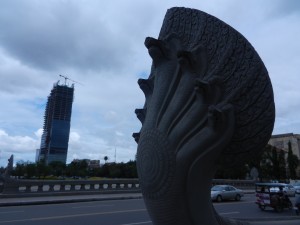I said that I don’t have any bizarre animal fetishes. So why write about snakes?
They’re hard not to notice in Southeast Asia. Nagas (snakes from Indian mythology) are all over Angkor Wat, and other temples in Cambodia, Thailand and Laos. They have a lot of meanings which can take you into some of the depths of Southeast Asian thought. Explore, if you dare.
According to Heinrich Zimmer, Nagas were worshipped in pre-Vedic India–way back before 1500BCE. They guard rivers and ponds, and are thus linked with flowing waters and abundant fish. Snakes are easily associated with fertility. Nagas were already an old symbol when Indians arrived in Southeast Asia about 2,000 years ago.
Nagas represent life’s energy and people’s prosperity on many levels:
1. Shedding their skins whole, they represent biological fertility–the family and the herd of animals grow.
2. They slither underground, so it’s easy to link them with the power of the land to generate crops.
3. Some live in the sea and in rivers, so it’s easy to link them with rains.
4. They cross between many domains–they slither through soil and into rocks, and they climb trees and swim in water. This flexibility encouraged people to associate them with spirit–they’re not bound to the constraints that other animals are. Ancient Indians imagined Kundalini energy as a serpent.
5. They have also represented healing in many cultures. They can form a circle by biting their own tails, so they represent wholeness.
6. They also seem primal, and they’re thus closely associated with cultural origins. Some African Bushmen have believed that people descended from snakes. It was a serpent that gave Eve the apple.
7. Serpents have also been associated with desire and sexuality. Many cultures have noted their phallic resemblances.
So snakes’ complex symbolism gives them a ubiquity that has made them one of human culture’s most widely spread symbols. They slither and thus seem infused with life-force–they’re pure energy, which generates life.
The naga was one of the main ways that Indian religions (Hinduism and Buddhism) were assimilated in Southeast Asia 2,000 years ago.
It was a key meeting point between two great cultures, so it’s worth examining closely. Features of Southeast Asian life were already friendly to nagas, and its people already had their own snake lore.
Images and ideas of Nagas have been so prevalent in Southeast Asia that they’re still potent symbols. I found the 7 headed naga in the above photo while walking past Phnom Penh’s tallest skyscraper. Yes, Cambodia’s government is full of snakes. But this symbol invokes a more glorious past. We’ll explore it in the next post on serpent lore in Southeast Asia.





{ 2 comments }
It is said that four weeks after the Buddha began meditating under the Bodhi Tree, the heavens darkened for seven days, and a prodigious rain descended. However, the mighty king of serpents, Mucalinda, came from beneath the earth and protected with his hood the one who is the source of all protection. When the great storm had cleared, the serpent king assumed his human form, bowed before the Buddha, and returned in joy to his palace. (http://www.dhammawiki.com/index.php?title=Mucalinda)
You read my mind, John. That story’s in my list of posts to write this weekend. Khmers made lots of images of a serpent spreading his many heads over the Buddha. Few escaped my camera!
Comments on this entry are closed.